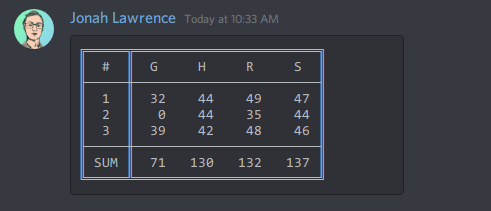An intuitive and type-safe library for converting 2D Python lists to fancy ASCII/Unicode tables
Documentation and examples are available at table2ascii.rtfd.io
pip install -U table2ascii
Requirements: Python 3.7+
from table2ascii import table2ascii output = table2ascii( header=["#", "G", "H", "R", "S"], body=[["1", "30", "40", "35", "30"], ["2", "30", "40", "35", "30"]], footer=["SUM", "130", "140", "135", "130"], ) print(output) """ ╔═════════════════════════════╗ ║ # G H R S ║ ╟─────────────────────────────╢ ║ 1 30 40 35 30 ║ ║ 2 30 40 35 30 ║ ╟─────────────────────────────╢ ║ SUM 130 140 135 130 ║ ╚═════════════════════════════╝ """from table2ascii import table2ascii output = table2ascii( body=[["Assignment", "30", "40", "35", "30"], ["Bonus", "10", "20", "5", "10"]], first_col_heading=True, ) print(output) """ ╔════════════╦═══════════════════╗ ║ Assignment ║ 30 40 35 30 ║ ║ Bonus ║ 10 20 5 10 ║ ╚════════════╩═══════════════════╝ """from table2ascii import table2ascii, Alignment output = table2ascii( header=["Product", "Category", "Price", "Rating"], body=[ ["Milk", "Dairy", "$2.99", "6.283"], ["Cheese", "Dairy", "$10.99", "8.2"], ["Apples", "Produce", "$0.99", "10.00"], ], column_widths=[12, 12, 12, 12], alignments=[Alignment.LEFT, Alignment.CENTER, Alignment.RIGHT, Alignment.DECIMAL], ) print(output) """ ╔═══════════════════════════════════════════════════╗ ║ Product Category Price Rating ║ ╟───────────────────────────────────────────────────╢ ║ Milk Dairy $2.99 6.283 ║ ║ Cheese Dairy $10.99 8.2 ║ ║ Apples Produce $0.99 10.00 ║ ╚═══════════════════════════════════════════════════╝ """See a list of 30+ preset styles here.
from table2ascii import table2ascii, Alignment, PresetStyle output = table2ascii( header=["First", "Second", "Third", "Fourth"], body=[["10", "30", "40", "35"], ["20", "10", "20", "5"]], column_widths=[10, 10, 10, 10], style=PresetStyle.ascii_box ) print(output) """ +----------+----------+----------+----------+ | First | Second | Third | Fourth | +----------+----------+----------+----------+ | 10 | 30 | 40 | 35 | +----------+----------+----------+----------+ | 20 | 10 | 20 | 5 | +----------+----------+----------+----------+ """ output = table2ascii( header=["First", "Second", "Third", "Fourth"], body=[["10", "30", "40", "35"], ["20", "10", "20", "5"]], style=PresetStyle.plain, cell_padding=0, alignments=Alignment.LEFT, ) print(output) """ First Second Third Fourth 10 30 40 35 20 10 20 5 """Check TableStyle for more info and PresetStyle for examples.
from table2ascii import table2ascii, TableStyle my_style = TableStyle.from_string("*-..*||:+-+:+ *''*") output = table2ascii( header=["First", "Second", "Third"], body=[["10", "30", "40"], ["20", "10", "20"], ["30", "20", "30"]], style=my_style ) print(output) """ *-------.--------.-------* | First : Second : Third | +-------:--------:-------+ | 10 : 30 : 40 | | 20 : 10 : 20 | | 30 : 20 : 30 | *-------'--------'-------* """from table2ascii import table2ascii, Merge, PresetStyle output = table2ascii( header=["#", "G", "Merge", Merge.LEFT, "S"], body=[ [1, 5, 6, 200, Merge.LEFT], [2, "E", "Long cell", Merge.LEFT, Merge.LEFT], ["Bonus", Merge.LEFT, Merge.LEFT, "F", "G"], ], footer=["SUM", "100", "200", Merge.LEFT, "300"], style=PresetStyle.double_thin_box, first_col_heading=True, ) print(output) """ ╔═════╦═════╤═══════╤═════╗ ║ # ║ G │ Merge │ S ║ ╠═════╬═════╪═══╤═══╧═════╣ ║ 1 ║ 5 │ 6 │ 200 ║ ╟─────╫─────┼───┴─────────╢ ║ 2 ║ E │ Long cell ║ ╟─────╨─────┴───┬───┬─────╢ ║ Bonus │ F │ G ║ ╠═════╦═════╤═══╧═══╪═════╣ ║ SUM ║ 100 │ 200 │ 300 ║ ╚═════╩═════╧═══════╧═════╝ """All parameters are optional. At least one of header, body, and footer must be provided.
Refer to the documentation for more information.
| Option | Supported Types | Description |
|---|---|---|
header | Sequence[SupportsStr], None(Default: None) | First table row seperated by header row separator. Values should support str() |
body | Sequence[Sequence[SupportsStr]], None(Default: None) | 2D List of rows for the main section of the table. Values should support str() |
footer | Sequence[SupportsStr], None(Default: None) | Last table row seperated by header row separator. Values should support str() |
column_widths | Sequence[Optional[int]], None(Default: None / automatic) | List of column widths in characters for each column |
alignments | Sequence[Alignment], Alignment, None(Default: None / all centered) | Column alignments (ex. [Alignment.LEFT, Alignment.CENTER, Alignment.RIGHT, Alignment.DECIMAL]) |
number_alignments | Sequence[Alignment], Alignment, None(Default: None) | Column alignments for numeric values. alignments will be used if not specified. |
style | TableStyle(Default: double_thin_compact) | Table style to use for the table* |
first_col_heading | bool(Default: False) | Whether to add a heading column separator after the first column |
last_col_heading | bool(Default: False) | Whether to add a heading column separator before the last column |
cell_padding | int(Default: 1) | The minimum number of spaces to add between the cell content and the cell border |
use_wcwidth | bool(Default: True) | Whether to use wcwidth instead of len() to calculate cell width |
*See a list of all preset styles here.
See the API Reference for more info.
- Display tables nicely inside markdown code blocks on Discord
- Useful for making Discord bots with Discord.py
- Tables display nicely whenever monospace fonts are fully supported
- Tables make terminal outputs look more professional
Contributions are welcome!
See CONTRIBUTING.md for more details on how to get involved.






